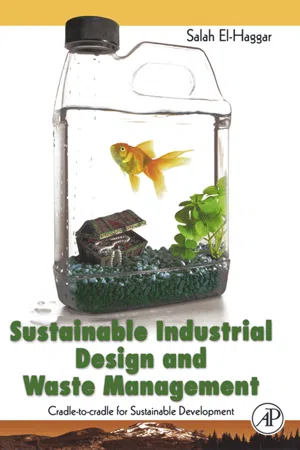
Sustainable Industrial Design and Waste Management
Cradle-to-Cradle for Sustainable Development
- 424 pages
- English
- ePUB (mobile friendly)
- Available on iOS & Android
Sustainable Industrial Design and Waste Management
Cradle-to-Cradle for Sustainable Development
About this book
Sustainable Industrial Design and Waste Management was inspired by the need to have a text that enveloped awareness and solutions to the ongoing issues and concerns of waste generated from industry. The development of science and technology has increased human capacity to extract resources from nature and it is only recently that industries are being held accountable for the detrimental effects the waste they produce has on the environment. Increased governmental research, regulation and corporate accountability are digging up issues pertaining to pollution control and waste treatment and environmental protection.The traditional approach for clinical waste, agricultural waste, industrial waste, and municipal waste are depleting our natural resources. The main objective of this book is to conserve the natural resources by approaching 100 % full utilization of all types of wastes by cradle – to - cradle concepts, using Industrial Ecology methodology documented with case studies. Sustainable development and environmental protection cannot be achieved without establishing the concept of industrial ecology. The main tools necessary for establishing Industrial Ecology and sustainable development will be covered in the book. The concept of "industrial ecology will help the industrial system to be managed and operated more or less like a natural ecosystem hence causing as less damage as possible to the surrounding environment.- Numerous case studies allow the reader to adapt concepts according to personal interest/field- Reveals innovative technologies for the conservation of natural resources- The only book which provides an integrated approach for sustainable development including tools, methodology, and indicators for sustainable development
Frequently asked questions
- Essential is ideal for learners and professionals who enjoy exploring a wide range of subjects. Access the Essential Library with 800,000+ trusted titles and best-sellers across business, personal growth, and the humanities. Includes unlimited reading time and Standard Read Aloud voice.
- Complete: Perfect for advanced learners and researchers needing full, unrestricted access. Unlock 1.4M+ books across hundreds of subjects, including academic and specialized titles. The Complete Plan also includes advanced features like Premium Read Aloud and Research Assistant.
Please note we cannot support devices running on iOS 13 and Android 7 or earlier. Learn more about using the app.
Information
Current Practice and Future Sustainability
Publisher Summary
1.1 Introduction
1.2 Waste Management
1.3 Treatment
Table of contents
- Cover image
- Title page
- Table of Contents
- Acknowledgments
- About the author
- Introduction
- Chapter 1: Current Practice and Future Sustainability
- Chapter 2: Cleaner Production
- Chapter 3: Sustainable Development and Industrial Ecology
- Chapter 4: Sustainable Development and Environmental Reform
- Chapter 5: Sustainability of Municipal Solid Waste Management
- Chapter 6: Recycling of Municipal Solid Waste Rejects
- Chapter 7: Sustainability of Agricultural and Rural Waste Management
- Chapter 8: Sustainability of Construction and Demolition Waste Management
- Chapter 9: Sustainability of Clinical Solid Waste Management
- Chapter 10: Sustainability of Industrial Waste Management
- References
- Index